Antique Chinese Blue & White Porcelain Artemisia Leaf Ginger Jar Kangxi Peroid
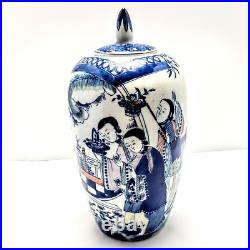
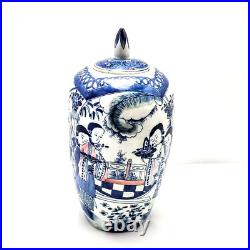

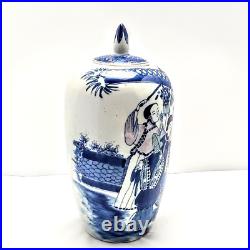

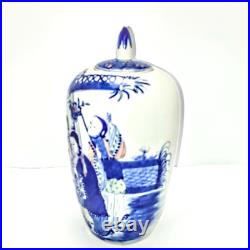
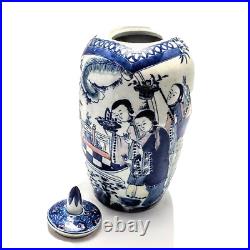
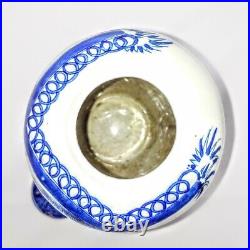
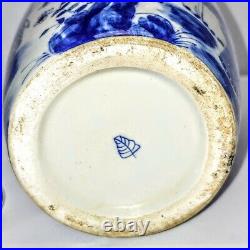

Antique Chinese Blue and White Porcelain'Artemisia Leaf' Ginger Jar, Kangxi Peroid. Antique Chinese 19th Century Porcelain Kangxi Artemisia Leaf Mark Bud Vase Here's a 19th century Chinese hand painted blue and white bud vase.
The Ginger Jar stands 10 tall with lid and bears the Artemisia leaf mark used during the Kangxi period. The Ginger Jar is in excellent original condition with no chips, cracks or damage. Artistically, the decoration on Chinese ceramics from this period can be characterized as freely painted and often depicting subjects such as: scholars in mountainous river landscapes; scrolling floral designs; elegant ladies; and scenes from popular stories. These designs, particularly on export porcelain are densely painted, often with a central scene surrounded by a geometric patterned border, or, flower-petal-shaped panels. Popular romances and epics such as'Romance of the Western Chamber','The Three Kingdoms', and'The Water Margin' were widely circulated at the time as woodblock printed books, which means that if one cares to look, many of the scenes on Kangxi porcelain are readily identifiable. The largest body of marks found on Kangxi porcelain have one of the following: no marks, pictorial marks, apocryphal marks, or blank marks within an underglaze blue circle.Because of the strictness in regulating his reign mark, potters employed alternatives such as having only an underglaze blue double circle, or an auspicious symbol, for instance an artemisia leaf, a lingzhi fungus, a precious object, or an auspicious character, such as yu (jade)? The most common apocryphal marks (marks referring to a previous ruler) found are those bearing the names of Chenghua and Jiajing emperors, and sometimes Wanli emperor.
I always inspect items in detail and list any major faults such as cracks & chips in the description. You should expect some age-related signs of wear such as very small fine surface scratches/marks. Also many of the items are handmade, they may have small imperfections such as bubbles, inclusions & lumps within the glass and often tool marks from where they have been shaped and worked in the manufacturing process. These are not usually seen by collectors as faults or damage, but as part of the character of handmade glass and are not usually mentioned in the description. This item is in the category "Antiques\Asian Antiques\China\Vases". The seller is "charliebou" and is located in this country: US. This item can be shipped to United States, New Zealand, Fiji, Papua New Guinea, Wallis and Futuna, Gambia, Malaysia, Taiwan, Poland, Oman, Suriname, United Arab Emirates, Kenya, Argentina, Guinea-Bissau, Armenia, Uzbekistan, Bhutan, Senegal, Togo, Ireland, Qatar, Burundi, Netherlands, Slovakia, Slovenia, Equatorial Guinea, Thailand, Aruba, Sweden, Iceland, Macedonia, Belgium, Israel, Liechtenstein, Kuwait, Benin, Algeria, Antigua and Barbuda, Swaziland, Italy, Tanzania, Pakistan, Burkina Faso, Panama, Singapore, Kyrgyzstan, Switzerland, Djibouti, Chile, China, Mali, Botswana, Republic of Croatia, Cambodia, Indonesia, Portugal, Tajikistan, Vietnam, Malta, Cayman Islands, Paraguay, Saint Helena, Cyprus, Seychelles, Rwanda, Bangladesh, Australia, Austria, Sri Lanka, Gabon Republic, Zimbabwe, Bulgaria, Czech Republic, Norway, Côte d'Ivoire (Ivory Coast), Kiribati, Turkmenistan, Grenada, Greece, Haiti, Greenland, Yemen, Afghanistan, Montenegro, Mongolia, Nepal, Bahamas, Bahrain, United Kingdom, Bosnia and Herzegovina, Hungary, Angola, Western Samoa, France, Mozambique, Namibia, Peru, Denmark, Guatemala, Solomon Islands, Vatican City State, Sierra Leone, Nauru, Anguilla, El Salvador, Dominican Republic, Cameroon, Guyana, Azerbaijan Republic, Macau, Georgia, Tonga, San Marino, Eritrea, Saint Kitts-Nevis, Morocco, Saint Vincent and the Grenadines, Mauritania, Belize, Philippines, Democratic Republic of the Congo, Republic of the Congo, Colombia, Spain, Estonia, Bermuda, Montserrat, Zambia, South Korea, Vanuatu, Ecuador, Albania, Ethiopia, Monaco, Niger, Laos, Ghana, Cape Verde Islands, Moldova, Madagascar, Saint Pierre and Miquelon, Lebanon, Liberia, Bolivia, Maldives, Gibraltar, Hong Kong, Central African Republic, Lesotho, Nigeria, Mauritius, Saint Lucia, Jordan, Guinea, Canada, Turks and Caicos Islands, Chad, Andorra, Romania, Costa Rica, India, Mexico, Serbia, Kazakhstan, Saudi Arabia, Japan, Lithuania, Trinidad and Tobago, Malawi, Nicaragua, Finland, Tunisia, Uganda, Luxembourg, Brazil, Turkey, Germany, Egypt, Latvia, Jamaica, South Africa, Brunei Darussalam, Honduras.- Featured Refinements: Kangxi
- Region of Origin: China
- Age: Pre-1800
- Primary Material: Porcelain & Pottery
- Maker: Artemisia Leaf
- Original/Reproduction: Antique Original
- Color: Blue and white
